Purchasing Special Orders
In a sales order, special order items and items with a Drop Ship purchase method must be "purchased" before the sales order can be processed. The purchasing step is accomplished by linking the sales order to the purchase order. This step can be done using any of the following steps:
-
Linking the purchase directly from the sales order detail line. This option is useful when a single line item is purchased immediately from the vendor.
-
Purchasing the entire sales order. This purchase option is used extensively for drop ship orders or when most of the sales order lines are purchased immediately from the vendor.
-
Purchasing special order items from the Special Orders tab of the Purchasing screen (Inventory > Purchasing). This popular option allows the user to purchase special order items after the sales order is created and saved. This option should be used when the purchasing staff places orders for products sold by a separate sales team. Using the Purchasing page facilitates the ordering of special order items and stocked items from a common interface.
-
Receiving and processing special orders. Review Receiving and Processing Special Orders for steps to process special orders when they arrive from the vendor.
-
Creating a purchase order from the MyTime app. Review Adding Products to a Task or Work Order for more details on this method of special order purchasing.
Note that purchase order lines can be created from a sales order without using an inventory item. The Quantity, Description, and Vendor Part Number are copied to the purchase order with any of the four purchasing options.
Linking special orders and drop shipments to a purchase order should be done at the time the items are ordered from the vendor. Review the instructions below for each of the three linking options:
An internal manufacturing vendor setting should be set as the optional Vendor if the special order product is manufactured instead of purchased. Review Manufacturing Vendor for setup details.
Linking the purchase directly from the sales order detail line
-
Right-click on the detail line to link a purchase order directly to a specific line item of a sales order by selecting Create Purchase Invoice from the context menu.
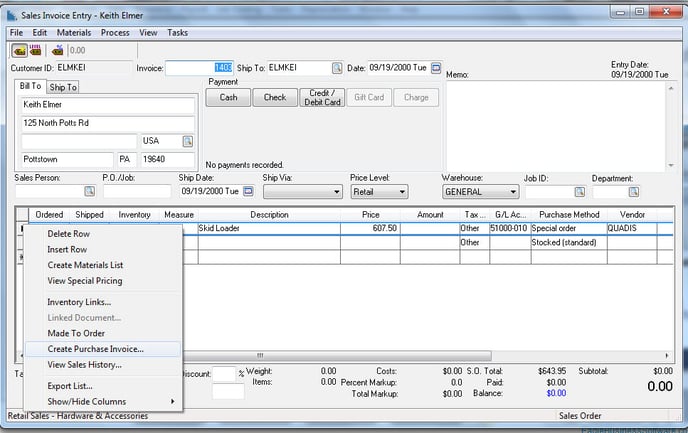
The Create Purchase Invoice option will only appear if the Purchase Method is set to Special Order, Drop Shop, or Replenishment and if a Vendor is entered. The option will also not be available if the line item has already been linked to a purchase order. (The following dialog will not appear if the Purchase Method is set to Drop Ship.)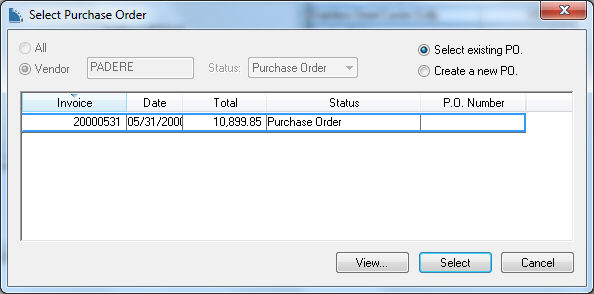
-
Select the Create a new PO option if you do not wish to append to an existing purchase order.
-
Click on the Select existing PO and configure the All or Vendor settings to select an existing purchase order from the table.
-
Click on the Select button (for existing POs) or the Create button (for a new PO) to create the purchase order as shown below:
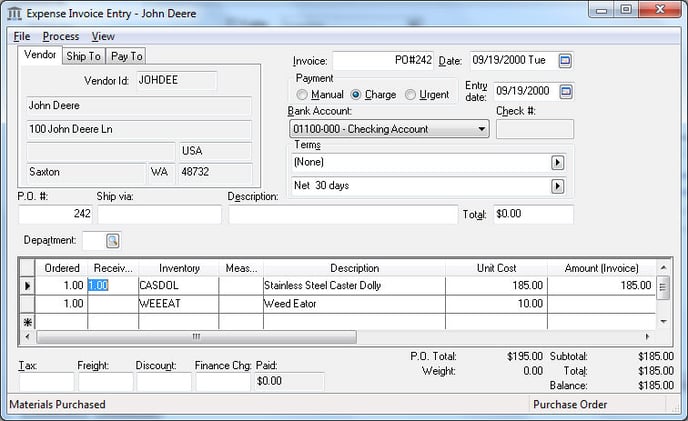
The Ordered quantity, Description, and Vendor Part Number are copied from the sales order to the Received, Description, and Vendor Part Number columns of the purchase order.
The Received quantity of the purchase order is linked to the Shipped quantity of the sales order if the Purchase Method is set as Drop Ship or Sync Quantities. These special order transactions will not affect the inventory On Hand count of the inventory item, since these values always match. Use the Associated purchase method if the quantity fields should not be synchronized. Populate the Received quantity when special order items are received from the vendor.
Drop shipments will never be handled by the user, since the product is shipped directly from the vendor to the customer. Populate and process both invoices at the time the product has been shipped to the customer and the sales order is processed. The Shipping Customer ID within the Ship To tab of the purchase order will be populated with the Customer ID within the sales order for drop ship purchase orders.
Right-click on any of the drop ship detail lines of the purchase order and select Linked Document from the context menu to view the associated drop ship sales order.
Purchase the entire sales order
This purchasing option is the recommended method used for sales orders that contain drop shipped items, especially if the sales order includes multiple items that are shipped on the same purchase order.
-
Open the sales order and select Process > Create Purchase Orders(s) from the sales order menu, as shown below:
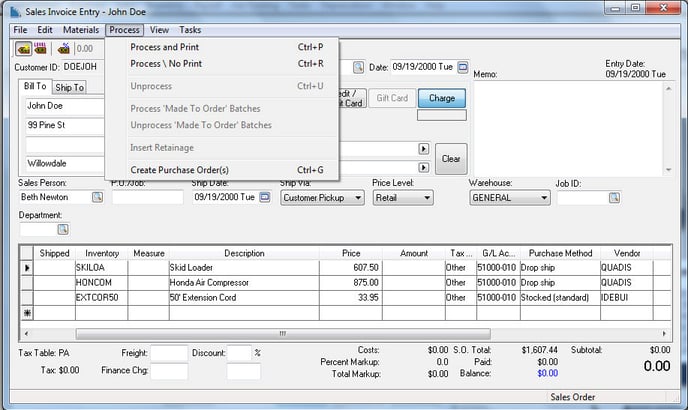
Review the previous section for details on the wizard to create the purchase order.
Purchase Special Order Items from the Special Orders Tab of the Purchasing Screen
The Purchasing Page contains a Special Orders tab that lists all the special orders and drop shipments that are not linked to a purchase order.
-
Go to Inventory > Purchasing from the EBMS menu or main page to launch the Purchasing page. Click on the Special Orders tab as shown below:
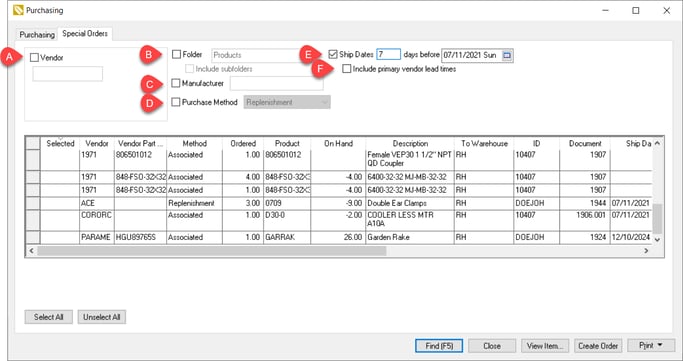
-
Click on the Find (F5) button or hit the F5 key on your keyboard to list all the special order items the match the query options set at the top of the window. All special order items will be listed if the filtering query options are left blank, as shown above. Set any of the following query options to limit the special order list:
-
Select the Vendor option to list only the special orders that are set to be purchased from the selected Vendor.
-
Select the Folder and the Include Subfolders options to limit the list to special order items from a specific folder group or subfolders. Review the Adding and Deleting Product Categories section for more details on inventory item category folders.
-
Enable the Manufacturer option to list only items associated by a single manufacturer. The Manufacturer setting is found within the General tab of the inventory item.
-
Enable the Purchase Method option and select a specific method to limit the special order lists to one of these Purchase Method settings: Drop Ship, Replenishment, Sync Quantities, or Associated. Review the Purchase Methods section for more details on these options.
-
Note that the Find (F5) button must be clicked to refresh the list of items.
-
Enable the Ship Dates on or before [selected date] filter to remove any orders that are outside the selected date range. Uncheck this option to list ALL orders, even future orders. Select this option to remove special orders that are scheduled in the future, outside the given date range. This filter calculates from the Ship Date on the sales order.
-
Enable Include vendor lead times to add the vendor lead days to the equation. Include all orders that have an order Ship Date that is less than the specified date minus the lead days for the selected vendor. Review Estimated Time of Arrival (ETA) Date for details on lead days. Some documents use a transfer date when the Ship Date is not included in the document.
-
-
Check the Selected column (the first column of item list on the special orders tab) for each item you wish to place on the purchase order. Click on the Create Order button to link any Selected special orders to a purchase order.
Enable the View when creating purchase order option on the Inventory > Options > General tab to view the PO when selecting Create Order on the Inventory > Purchasing page. Review the Using the Purchasing Page to Create Purchase Orders for details on this option.
Receiving and Processing Special Orders
Review Receiving and Processing Special Orders for steps to process the receiving of special orders from the vendor.